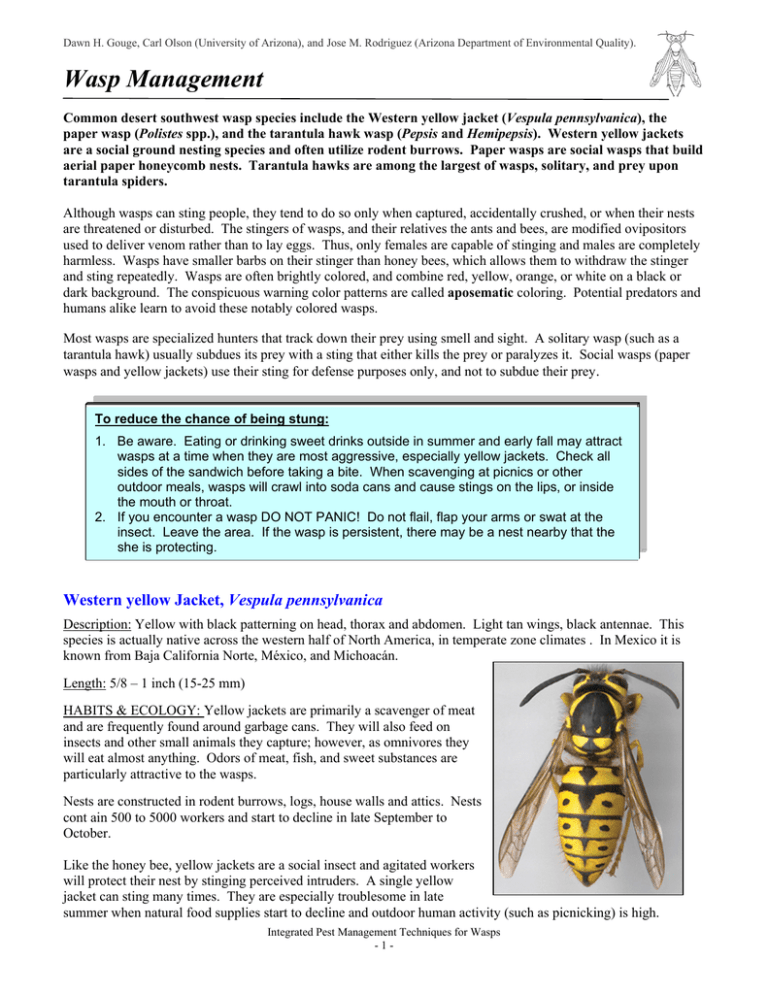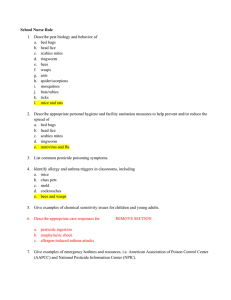Document 10755853
advertisement

Dawn H. Gouge, Carl Olson (University of Arizona), and Jose M. Rodriguez (Arizona Department of Environmental Quality). Wasp Management Common desert southwest wasp species include the Western yellow jacket (Vespula pennsylvanica), the paper wasp (Polistes spp.), and the tarantula hawk wasp (Pepsis and Hemipepsis). Western yellow jackets are a social ground nesting species and often utilize rodent burrows. Paper wasps are social wasps that build aerial paper honeycomb nests. Tarantula hawks are among the largest of wasps, solitary, and prey upon tarantula spiders. Although wasps can sting people, they tend to do so only when captured, accidentally crushed, or when their nests are threatened or disturbed. The stingers of wasps, and their relatives the ants and bees, are modified ovipositors used to deliver venom rather than to lay eggs. Thus, only females are capable of stinging and males are completely harmless. Wasps have smaller barbs on their stinger than honey bees, which allows them to withdraw the stinger and sting repeatedly. Wasps are often brightly colored, and combine red, yellow, orange, or white on a black or dark background. The conspicuous warning color patterns are called aposematic coloring. Potential predators and humans alike learn to avoid these notably colored wasps. Most wasps are specialized hunters that track down their prey using smell and sight. A solitary wasp (such as a tarantula hawk) usually subdues its prey with a sting that either kills the prey or paralyzes it. Social wasps (paper wasps and yellow jackets) use their sting for defense purposes only, and not to subdue their prey. To reduce the chance of being stung: 1. Be aware. Eating or drinking sweet drinks outside in summer and early fall may attract wasps at a time when they are most aggressive, especially yellow jackets. Check all sides of the sandwich before taking a bite. When scavenging at picnics or other outdoor meals, wasps will crawl into soda cans and cause stings on the lips, or inside the mouth or throat. 2. If you encounter a wasp DO NOT PANIC! Do not flail, flap your arms or swat at the insect. Leave the area. If the wasp is persistent, there may be a nest nearby that the she is protecting. Western yellow Jacket, Vespula pennsylvanica Description: Yellow with black patterning on head, thorax and abdomen. Light tan wings, black antennae. This species is actually native across the western half of North America, in temperate zone climates . In Mexico it is known from Baja California Norte, México, and Michoacán. Length: 5/8 – 1 inch (15-25 mm) HABITS & ECOLOGY: Yellow jackets are primarily a scavenger of meat and are frequently found around garbage cans. They will also feed on insects and other small animals they capture; however, as omnivores they will eat almost anything. Odors of meat, fish, and sweet substances are particularly attractive to the wasps. Nests are constructed in rodent burrows, logs, house walls and attics. Nests cont ain 500 to 5000 workers and start to decline in late September to October. Like the honey bee, yellow jackets are a social insect and agitated workers will protect their nest by stinging perceived intruders. A single yellow jacket can sting many times. They are especially troublesome in late summer when natural food supplies start to decline and outdoor human activity (such as picnicking) is high. Integrated Pest Management Techniques for Wasps -1- Dawn H. Gouge, Carl Olson (University of Arizona), and Jose M. Rodriguez (Arizona Department of Environmental Quality). Irrational fear of yellow jackets can lead to irrational behavior, which is more likely to result in being stung or causing injury. If you discover activity near a hole in the ground or a log, it is likely a nest; remain at least 10 feet away. Get a professional who is trained and has the correct equipment to remediate the nest if necessary. Paper wasps, Polistes spp. Description: long, thin body, a narrow waist (called a petiole). Appear smooth and hairless. Length: about 1” (20 to 25 mm) HABITS & ECOLOGY: There are three common paper wasps in Arizona: the yellow paper wasp (Polistes flavus), the Navajo paper wasp (Mischocyttarus navajo), which is deep chocolate-brown with the end of the abdomen yellowish; and the Arizona paper wasp (Polistes exclamans arizonicus), which is slightly smaller and spindleshaped and is brownish-red with thin yellow cross bands on the abdomen. Paper wasps are large social wasps that build paper honeycomb nests. Paper wasps do not sting their prey. Paper wasps use their powerful cutting mandibles to chew prey into pieces to feed directly to their larvae. They consume pests and are considered beneficial. Paper wasp activity begins in the spring with a single queen constructing her nest. In urban environments nests may be located on ceiling overhangs, window sills, etc. As the young mature and emerge, they take over the duties of feeding larvae and nest maintenance; the queen’s job becomes simply to lay eggs. The nest continues to grow in size throughout the spring and summer months. In the fall, the nest is abandoned, never to be reused. The workers die off, and queen wasps may congregate and overwinter together in protected spaces such as wall voids, attics, etc. On warm winter days they may emerge; however, they are least likely to sting at these times. Paper wasps rarely sting humans at any time. Tarantula hawk, Pepsis spp. and Hemipepsis spp. Description: large, metallic blue-black wasps with either blue-black or bright orange wings and black antennae. Their body is robust compared to other wasps. Length: over 2” long. HABITS & ECOLOGY: Tarantula hawks are in the family Pompilidae and are also called spider wasps. Tarantula hawks are nectivorous, feeding on flower nectar or the juice of damaged fruits. They have a fondness for sweet, fermented fruit and may behave drunkenly after consuming it. They are often seen around blossoms during the summer. Tarantula hawk larvae are helpless as grubs and depend on their mothers to provide them with a large spider for food. The female tarantula hawk searches for a large spider prey at dusk or nighttime by running wildly across the ground, employing her keen sense of smell to find a tarantula burrow. The wasp vibrates the spider’s silk strands around the entrance, mimicking a potential prey. When the tarantula emerges, the wasp maneuvers into position and delivers a sting which immediately paralyzes the spider. The wasp then drags her victim to a previously dug hole in the area or utilizes the tarantula’s own burrow, and deposits a single egg on the spider and closes off the burrow. Paralyzed and still alive, the tarantula serves as food for the tarantula hawk larva for several months. The larva completes its development in the burrow. Tarantula hawks typically ignore humans; however, they can be induced to sting if sufficiently agitated. Their sting is less damaging than a fire ant or honey bee, but it is rated as the most painful of any insect in North America. Your IPM specialist may use management techniques that for utilize insecticidal soaps, synthetic Integrated Pest Management Techniques Wasps - 2 - temperatures to remove the wasps and their nest. pesticides, or simply take advantage of cool ambient








